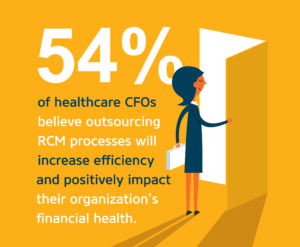June 5, 2018
Doing More with Less: Rev Cycle’s Future Reality and a Fresh Look at Revenue

The age of value-based care is here, and for revenue cycle leadership, that means it’s time to rethink how we respond to challenges. Today’s problems are going to require leaders who think like MacGyver — able to do more with less in situations in which most people don’t even dream of finding themselves.
Pulling this off is going to require going beyond yesterday’s goals of increasing patient volumes and driving down bad debt. It’s going to take a new look at cost-cutting, along with the metrics and analytics that make sure those cuts are happening in all the right places — a three-pronged approach that leverages technology to navigate pressing revenue cycle challenges and improve the financial experience for your patients.
Where to Cut Costs
The hospital revenue cycle naturally has a wealth of opportunities to cut costs. One of the best-tested approaches is business process outsourcing. BPO lets you dig into process management and get away from the habits of yesterday that are likely holding you back.
 Outsourcing business functions like AR, contract management, denials management, and even workers comp and auto claims management can be a quick trip to lower costs. Consider this — Black Book Market Research found that 54 percent of health organization CFOs believed that outsourcing revenue cycle management processes could open up doors to efficiency. This number will probably increase as alternative payment models take deeper hold.
Outsourcing business functions like AR, contract management, denials management, and even workers comp and auto claims management can be a quick trip to lower costs. Consider this — Black Book Market Research found that 54 percent of health organization CFOs believed that outsourcing revenue cycle management processes could open up doors to efficiency. This number will probably increase as alternative payment models take deeper hold.
While you’re answering the outsourcing question, you’re probably going to run headlong into a few silos. Most revenue cycle departments run with relatively clean lines between front and back end, but for some organizations, an approach that once allowed for specialization and efficiency has turned into a tangle of roadblocks and speedbumps between front- and back-end processes. That’s not good enough anymore. Cross-training and helping your staff understand where they fit in the patient financial experience can help increase efficiency, reduce costs, and improve outcomes across the board.
You might also find that higher-tech solutions like robotics process automation are an efficient way to pass off costly functions that used to be performed by end users to “bots” who are better suited to navigate the complexity of value-based contract environments.
Your Most Important Metrics
Cost-cutting can be self-defeating if you aren’t tracking results. That means a need to take a deeper look at some familiar KPIs.
You’re probably tracking these now, but any cost-cutting initiatives should involve an increased focus on efficiency and cost-related KPIs. That includes:
- clean claims rate (and one of its root causes, pre-registration rate)
- claims denial rate
- collections rate
- cost to collect
Remember, though, that KPIs should be unique to your organization. The indicators that yield amazing insights for the hospital down the street might not do much for you in the long run. Optimizing your cost-cutting programs means selecting the KPIs that align with the areas of inefficiency you’ve seen in the past.
It’s Time for Analytics
Even after you’ve selected great KPIs, getting real mileage out of them starts with a look at analytics.
Your organization has a data story that’s just waiting to be told, and analytics are the best way to get there. They’re the shortcut to watching KPIs over the long term and using them to inform future investments in cost-cutting tech, better staffing and workflow processes, future outsourcing decisions, and even continuous process improvement. Analytics are what help you move away from expensive, reactive orientations that shred your revenues and chew up ROI.
So what does a step in that direction look like? You’re probably already getting some use out of analytics on the back end, but because of the uniquely quantifiable nature of the revenue cycle, you can apply analytics through almost every point from pre-service, to point of care, to billing and collections. Some of your business intelligence tools likely already offer analytics functionality, so communicate with your vendors and make sure you’re getting the most out of your existing analytics investment.
Remember MacGyver? This is where that approach really comes into play. The right use of analytics will help you start developing the custom KPIs that align with your biggest year-end achievement goals and challenges.
Where RevSpring Comes in Handy
We know healthcare. That’s why we can put data to work for you and your customers. Our at-a-glance dashboards help healthcare organizations quickly find and close workflow gaps that are costing time, resources, and hard dollars. With seamless integration to your patient engagement workflows, RevSpring can make the largest impact on RCM efficiency your health system has ever experienced. Take the mystery out of revenue cycle management with RevSpring.
If you’d like to learn more about our comprehensive patient engagement and billing solutions, we’d love to help you. Request a demo to see how we can help your organization meet its goals or stop by Booth #225 at the HFMA Annual Conference in Las Vegas from June 24-26, 2018.